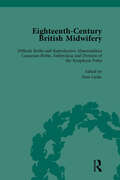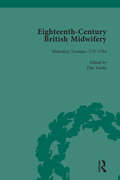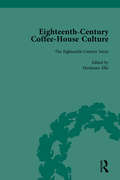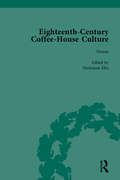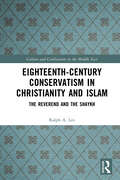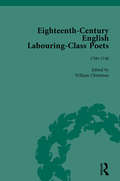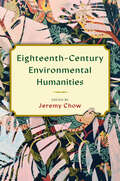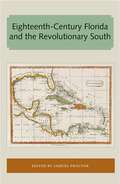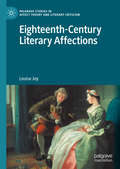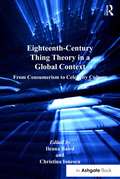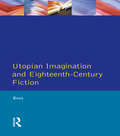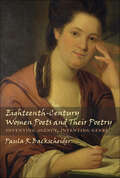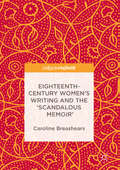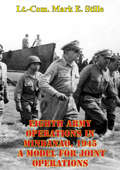- Table View
- List View
Eighteenth-Century British Midwifery, Part III vol 11
by Pam LieskeBy reprinting in facsimile primary texts on eighteenth-century midwifery and childbirth, this comprehensive twelve-volume collection gives readers a much deeper, more nuanced understanding of midwives, midwifery students, and women in labour.
Eighteenth-Century British Midwifery, Part III vol 12
by Pam LieskeBy reprinting in facsimile primary texts on eighteenth-century midwifery and childbirth, this comprehensive twelve-volume collection gives readers a much deeper, more nuanced understanding of midwives, midwifery students, and women in labour.
Eighteenth-Century British Midwifery, Part III vol 9
by Pam LieskeBy reprinting in facsimile primary texts on eighteenth-century midwifery and childbirth, this comprehensive twelve-volume collection gives readers a much deeper, more nuanced understanding of midwives, midwifery students, and women in labour.
Eighteenth-Century British Premiers: Walpole to the Younger Pitt
by Dick LeonardFollowing his earlier surveys of 19th and 20th Century British Prime Ministers, Dick Leonard turns his attention to their 18th Century predecessors, including such major figures as Robert Walpole, the Elder Pitt (Lord Chatham), Lord North and the Younger Pitt.
Eighteenth-Century Coffee-House Culture, vol 1: Vol 3
by Markman EllisHelps scholars and students form an understanding of the contribution made by the coffee-house to British and even American history and culture. This book attempts to make an intervention in debates about the nature of the public sphere and the culture of politeness. It is intended for historians and scholars of literature, science, and medicine.
Eighteenth-Century Coffee-House Culture, vol 2: Vol 3
by Markman EllisHelps scholars and students form an understanding of the contribution made by the coffee-house to British and even American history and culture. This book attempts to make an intervention in debates about the nature of the public sphere and the culture of politeness. It is intended for historians and scholars of literature, science, and medicine.
Eighteenth-Century Coffee-House Culture, vol 3: Vol 3
by Markman EllisHelps scholars and students form an understanding of the contribution made by the coffee-house to British and even American history and culture. This book attempts to make an intervention in debates about the nature of the public sphere and the culture of politeness. It is intended for historians and scholars of literature, science, and medicine.
Eighteenth-Century Coffee-House Culture, vol 4: Vol 3
by Markman EllisHelps scholars and students form an understanding of the contribution made by the coffee-house to British and even American history and culture. This book attempts to make an intervention in debates about the nature of the public sphere and the culture of politeness. It is intended for historians and scholars of literature, science, and medicine.
Eighteenth-Century Conservatism in Christianity and Islam: The Reverend and the Shaykh (Culture and Civilization in the Middle East)
by Ralph A. LeoThis book examines the world of religious conservatism in Christianity and Islam through a comparison of two eighteenth-century traditionalist icons, Jonathan Edwards and Muḥammad Ibn 'Abd al-Wahhāb.Spanning the globe from America to Arabia, this book explores the major themes in the lives and works of these most unlikely of bedfellows, the Reverend and the Shaykh. In many ways, Edwards and Ibn 'Abd al-Wahhāb are about as far apart as two figures could possibly be. Without minimizing their very real differences, however, this comparative study finds numerous parallels that beckon even the most conservative of Christians and Muslims to take a second look at their own faith, as well as the faith of the other. The numerous surprising congruences in the worlds of the Reverend and the Shaykh, as well as in their conceptions of God, humanity, and the faith of the other, suggest that we stand much to gain from a reassessment of long-held views that could lead to wholly new patterns of engagement.With implications in diverse fields such as politics, law, philosophy, theology, history, warfare and anthropology, this book unearths striking parallels in Edwards and Ibn 'Abd al-Wahhāb that have heretofore gone unnoticed or largely ignored.
Eighteenth-Century English
by Raymond HickeyThe eighteenth century was a key period in the development of the English language, in which the modern standard emerged and many dictionaries and grammars first appeared. This book is divided into thematic sections which deal with issues central to English in the eighteenth century. These include linguistic ideology and the grammatical tradition, the contribution of women to the writing of grammars, the interactions of writers at this time and how politeness was encoded in language, including that on a regional level. The contributions also discuss how language was seen and discussed in public and how grammarians, lexicographers, journalists, pamphleteers and publishers judged on-going change. The novel insights offered in this book extend our knowledge of the English language at the onset of the modern period.
Eighteenth-Century English Labouring-Class Poets, vol 1
by John Goodridge Simon Kövesi David Fairer Tim Burke William ChristmasPoets of labouring class origin were published in Britain in the 18th and 19th centuries. Some were popular and important in their day but few are available today. This is a collection of some of those poems from the 18th century.
Eighteenth-Century Environmental Humanities (Transits: Literature, Thought & Culture, 1650-1850)
by Shelby Johnson Jeremy Chow Elliot Patsoura Annette Hulbert Adam Sweeting Mariah Crilley Claire Campbell Jason Payton Matt Duquès Ami Yoon Christopher Allan Black Kate ScarthThis groundbreaking new volume unites eighteenth-century studies and the environmental humanities, showcasing how these fields can vibrantly benefit one another. In eleven chapters that engage a variety of eighteenth-century texts, contributors explore timely themes and topics such as climate change, new materialisms, the blue humanities, indigeneity and decoloniality, and green utopianism. Additionally, each chapter reflects on pedagogical concerns, asking: How do we teach eighteenth-century environmental humanities? With particular attention to the voices of early-career scholars who bring cutting-edge perspectives, these essays highlight vital and innovative trends that can enrich both disciplines, making them essential for classroom use.
Eighteenth-Century Florida and the Revolutionary South (Florida and the Caribbean Open Books Series)
by Samuel ProctorThe books in the Florida and the Caribbean Open Books Series demonstrate the University Press of Florida’s long history of publishing Latin American and Caribbean studies titles that connect in and through Florida, highlighting the connections between the Sunshine State and its neighboring islands. Books in this series show how early explorers found and settled Florida and the Caribbean. They tell the tales of early pioneers, both foreign and domestic. They examine topics critical to the area such as travel, migration, economic opportunity, and tourism. They look at the growth of Florida and the Caribbean and the attendant pressures on the environment, culture, urban development, and the movement of peoples, both forced and voluntary. The Florida and the Caribbean Open Books Series gathers the rich data available in these architectural, archaeological, cultural, and historical works, as well as the travelogues and naturalists’ sketches of the area in prior to the twentieth century, making it accessible for scholars and the general public alike. The Florida and the Caribbean Open Books Series is made possible through a grant from the National Endowment for the Humanities and the Andrew W. Mellon Foundation, under the Humanities Open Books program.
Eighteenth-Century Literary Affections (Palgrave Studies in Affect Theory and Literary Criticism)
by Louise JoyThis book assesses the mediating role played by 'affections' in eighteenth-century contestations about reason and passion, questioning their availability and desirability outside textual form. It examines the formulation and idealization of this affective category in works by Isaac Watts, Lord Shaftesbury, Mary Hays, William Godwin, Helen Maria Williams, and William Wordsworth. Part I outlines how affections are invested with utopian potential in theology, moral philosophy, and criticism, re-imagining what it might mean to know emotion. Part II considers attempts of writers at the end of the period to draw affections into literature as a means of negotiating a middle way between realism and idealism, expressivism and didacticism, particularity and abstraction, subjectivity and objectivity, femininity and masculinity, radicalism and conservatism, and the foreign and the domestic.
Eighteenth-Century Naval Officers: A Transnational Perspective (War, Culture and Society, 1750 –1850)
by Evan Wilson AnnaSara Hammar Jakob SeerupThis book surveys the lives and careers of naval officers across Europe at the height of the age of sail. It traces the professionalization of naval officers by exploring their preparation for life at sea and the challenges they faced while in command. It also demonstrates the uniqueness of the maritime experience, as long voyages and isolation at sea cemented their bond with naval officers across Europe while separating them from landlubbers. It depicts, in a way no previous study has, the parameters of their shared experiences—both the similarities that crossed national boundaries and connected officers, and the differences that can only be seen from an international perspective.
Eighteenth-Century Thing Theory in a Global Context: From Consumerism to Celebrity Culture
by Ileana Baird Christina IonescuExploring Enlightenment attitudes toward things and their relation to human subjects, this collection offers a geographically wide-ranging perspective on what the eighteenth century looked like beyond British or British-colonial borders. To highlight trends, fashions, and cultural imports of truly global significance, the contributors draw their case studies from Western Europe, Russia, Africa, Latin America, and Oceania. This survey underscores the multifarious ways in which new theoretical approaches, such as thing theory or material and visual culture studies, revise our understanding of the people and objects that inhabit the phenomenological spaces of the eighteenth century. Rather than focusing on a particular geographical area, or on the global as a juxtaposition of regions with a distinctive cultural footprint, this collection draws attention to the unforeseen relational maps drawn by things in their global peregrinations, celebrating the logic of serendipity that transforms the object into some-thing else when it is placed in a new locale.
Eighteenth-Century Transplantations: New Literary Lives, Forms and Contexts (Routledge Studies in Eighteenth-Century Literature)
by Jakub Lipski Joanna Maciulewicz Anna Paluchowska-MessingThis collection studies eighteenth-century British literature as enmeshed within a dynamic intercultural traffic, participating in the import and export of literary and cultural forms. Eighteenth-Century Transplantations places this transcultural circulation at the centre of attention and presents its products in a unique configuration. Literary transplants into the British context, out of it, and their transmedial afterlives are set together in order to showcase the mechanisms of such cultural commerce. The term 'transplantation', borrowed from medical and horticultural discourses and evocative of eighteenth-century experiments in gardening, is offered here as a useful kinetic model to conceptualize the diverse practices involved in relocating a literary text into a new cultural environment.
Eighteenth-Century Utopian Fiction (Studies In Eighteenth and Nineteenth Century Literature Series)
by Christine ReesUtopian fiction was a particularly rich and important genre during the eighteenth century. It was during this period that a relatively new phenomenon appeared: the merging of utopian writing per se with other fictional genres, such as the increasingly dominant novel. However, while early modern and nineteenth and twentieth century utopias have been the focus of much attention, the eighteenth century has largely been neglected. Utopian Imagination and Eighteenth Century Fiction combines these major areas of interest, interpreting some of the most fascinating and innovative fictions of the period and locating them in a continuing tradition of utopian writing which stretches back through the Renaissance to the Ancient World.Begining with a survey of the recurrent topics in utopian writing - power structures in the state, money, food, sex, the role of women, birth, education and death - the book brings together canonical eighteenth century texts countaining powerful utopian elements, such as Robinson Crusoe, Gulliver's Travels and Rasselas, and less familiar works, to examine the reworking of these topics in a new context. The unfamiliar texts, including Gaudentio di Lucca, are described in detail to give students an idea of relevant material across a broad area. A section is devoted specifically to women writes, an area which has become the focus of attention. The mixture of texts provides a useful cross-reference for students tackling the subject from various perspectives and the comprehensive bibliography provides a valuable tool for those with general or specific interests
Eighteenth-Century Women Poets and Their Poetry: Inventing Agency, Inventing Genre
by Paula R. Backscheider“Our sense of eighteenth-century poetic territory is immeasurably expanded by [this] excellent historical and cultural” study of UK women poets of the era (Cynthia Wall, Studies in English Literature).This major work offers a broad view of the writing and careers of eighteenth-century women poets, casting new light on the ways in which poetry was read and enjoyed, on changing poetic tastes in British culture, and on the development of many major poetic genres and traditions.Rather than presenting a chronological survey, Paula R. Backscheider explores the forms in which women wrote and the uses to which they put those forms. Considering more than forty women in relation to canonical male writers of the same era, she concludes that women wrote in all of the genres that men did but often adapted, revised, and even created new poetic kinds from traditional forms.Backscheider demonstrates that knowledge of these women’s poetry is necessary for an accurate and nuanced literary history. Within chapters on important verse forms, she sheds light on such topics as women’s use of religious poetry to express ideas about patriarchy and rape; the important role of friendship poetry; same-sex desire in elegy by women as well as by men; and the status of Charlotte Smith as a key figure of the long eighteenth century, not only as a Romantic-era poet.Co-Winner, James Russell Lowell Prize, Modern Language Association
Eighteenth-Century Women's Writing and the 'Scandalous Memoir'
by Caroline BreashearsThis book contributes to the literary history of eighteenth-century women's life writings, particularly those labeled "scandalous memoirs. " It examines how the evolution of this subgenre was shaped partially by several innovative memoirs that have received only modest critical attention. Breashears argues that Madame de La Touche's Apologie and her friend Lady Vane's Memoirs contributed to the crystallization of this sub-genre at mid-century, and that Lady Vane's collaboration with Tobias Smollett in The Adventures of Peregrine Pickle resulted in a brilliant experiment in the relationship between gender and genre. It demonstrates that the Memoirs of Catherine Jemmat incorporated influential new strategies for self-justification in response to changing kinship priorities, and that Margaret Coghlan's Memoirs introduced revolutionary themes that created a hybrid: the political scandalous memoir. This book will therefore appeal to scholars interested in life writing, women's history, genre theory, and eighteenth-century British literature.
Eighteenth-century Women: An Anthology (Routledge Library Editions: Women's History)
by Bridget HillWhen it was first published in 1984, this book filled an acknowledged gap in the social history of the period and made available hitherto inaccessible sources. The work draws on newspapers and journals, memoirs, diaries, courtesy books, county surveys and records, but also on the literature of the period, its novels, poetry and plays. It examines the role assigned to women in eighteenth-century society and the education thought fitting to perform it. It looks at attitudes to courtship and marriage, chastity and sexual passion. It explores the role of women as wives and mothers, as spinsters and widows, and focuses on the living and working experience of women whether in the home, agriculture, industry or domestic service. It contrasts the expectations of the rich and the poor, the leisured lady and the underpaid female agricultural labourer, the unmarried mother and the prostitute.
Eighth Air Force Bombing 20-25 February 1944: How Logistics Enabled Big Week To Be Big
by Major Jon M. Sutterfield USAFEighth Air Force (8AF) conducted the US's first thousand-bomber raids against Germany in February 1944--recorded in history as Big Week. Until that time the USAAF was not able to concentrate such firepower on the enemy in such a short period of time. It took much effort to make Big Week "big" covering the spectrum of planning and execution activities dating back to the end of World War I that were adapted and flexed to be successful in a different context. Indeed, the depth and breadth of the preparations required to successfully execute Big Week on the scale intended is deserving of a closer examination.Leadership from President Roosevelt to first line supervisors influenced 8AF logistics before February 1944. Major General Hugh J. Knerr was the one man that stood out as the champion of USAAF logistics. He influenced the concept of logistical operations in the ETO and, more specifically, put logistics on a level of importance equal to that of operations within the United States Strategic Air Forces (USSTAF). He synchronized logistics with operations and strove for constant improvement by making organizational and process changes aimed at increasing logistical responsiveness, effectiveness, and efficiency.The British provided tremendous host nation support including construction of new airfields, skilled and unskilled labor support, supply items, and transportation. The British host nation support 8AF received far surpassed what a cursory review of World War II history leads one to believe and serves as a model for US-led coalition operations in the 21st century. The US Merchant Marine and US Navy provided sealift of goods from the stateside depots to the theater. The US Army provided supply support of common items and Air Service Command (ASC) provided technical and supply support. Last, but not least, both civil servants and civilian contractors provided depot maintenance and in-theater technical support.
Eighth Army Operations In Mindanao, 1945 A Model For Joint Operations
by Colonel Joseph G. Terry Jr.While amphibious operations have historically straddled single service prerogatives and had been conspicuously avoided prior to World War II, in the Pacific area of operations during World War II such operations were abundant, decisive and generally regarded as models of joint service cooperation. Under the legendary General Douglas MacArthur, the Philippine Campaign in 1944-45 was especially noteworthy as a model of a single flexible strategy, unity of command, and joint service cooperation. Yet forty-five years later, our national military experience in joint planning and operations has appeared to regress. The recent Goldwater-Nichols Department of Defense Reorganization Act of 1986, however, has elevated service interest in joint planning and operations. This study briefly discusses the Mindanao Operation (March-July 1945), one of several operations within the Philippine Campaign. The study focuses on the impact of existing joint doctrine on the planning, coordination and execution of operations and evidence of joint action to solve some specific and unique challenges encountered within the operation. A summary of the Mindanao operation and appropriate comments on its applicability as a model for today's joint operations complete this study.
Eighth Army in Italy, 1943-45: The Long Hard Slog
by Richard DohertyEighth Army, Britain's most famous field army of the twentieth century, landed in Italy in September 1943 and fought continously until the defeat of the Germans in early-May 1945. This book studies the experience of Eighth Army in the Italian campaign, examining how a force accustomed to the open spaces of North Africa adjusted to the difficult terrain of Italy where fighting became much more a matter for the infantry than for the armour. It also compares the qualities of the commanders of Eighth Army in Italy: Montgomery; Leese and, finally, McCreery. The book uses official records at various levels, personal accounts - some never before published - and published material to present a picture of an army that, although defined as British, was one of the war's most cosmopolitan formations. Its soldiers came from the UK, Canada, India, Ireland, Nepal, New Zealand, Poland and South Africa as well as from Palestine - the Jewish Brigade - and from Italy itself.
Eighth Army's Greatest Victories: Alam Halfa to Tunis 1942–1943
by Adrian TurnerTo read many accounts, it would appear that the Eighth Army's victory at El Alamein was quickly followed by its triumphant arrival at Tunis. Adrian Turner, the experienced authority on the period, redresses the imbalance by describing brilliantly the progress of this legendary fighting force and describing the ferocity of such battles as that for the Mareth Line. The author deftly handles strategic level thinking, the tactical battles and individual contributions. Aviation readers will be thrilled by recognition of the Desert Air Force's contribution, too often neglected.
